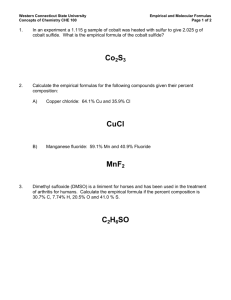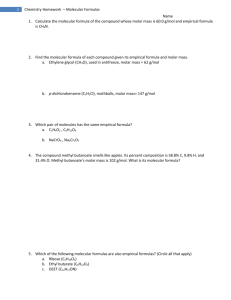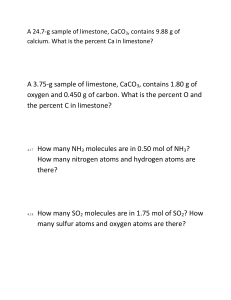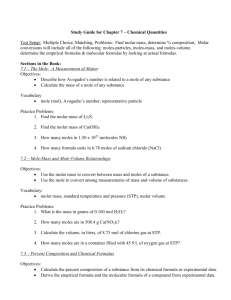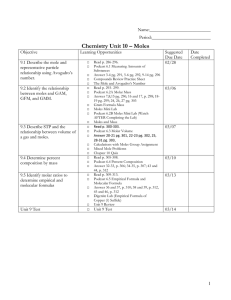7-3 Percent Composition & Formulas
advertisement
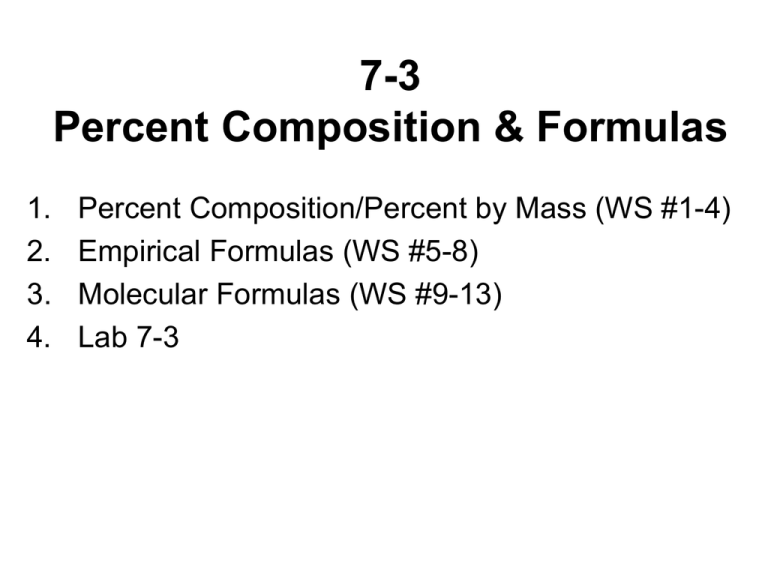
7-3 Percent Composition & Formulas 1. 2. 3. 4. Percent Composition/Percent by Mass (WS #1-4) Empirical Formulas (WS #5-8) Molecular Formulas (WS #9-13) Lab 7-3 7-2 Review/Practice 1. How many grams of aluminum oxide can be made from 2.44 moles of aluminum? 4 Al + 3 O2 2 Al2O3 2. How many molecules of oxygen gas are needed to react with 25.0 g of aluminum? 4 Al + 3 O2 2 Al2O3 Percent Composition/Percent by Mass/Mass Percent • tells how much mass each element contributes to the total mass of the compound • Percent = Mass of One Element x 100 Mass of Entire Compound • 2 Questions: – Find the percent composition of CuCl2. • Answer: Find the % of both copper and chlorine. – Find the mass percent of copper in CuCl2 • Answer: Find the % of just copper. Percent Composition/Percent by Mass/Mass Percent • Ex 1: Find the % composition of N2O4. [N2O4 92 g/mol] • Ex 2: Find the mass % of oxygen in Ca(NO3)2. [Ca(NO3)2 164 g/mol] Empirical Formulas • Simplest whole-number ratio of elements in a compound • Steps: 1. Find the number of moles of each element. 2. Identify the smallest number of moles. Then, divide all the moles by that smallest number. 3. Round up or down to get whole numbers for each element. --Exception: If you get something like 1.5, 2.5, 3.5, then multiply all your values by 2 to get the whole numbers. Empirical Formulas • Ex 3: Find the empirical formula of a compound containing 10.52 g Ni, 4.38 g C, and 5.10 g N. Empirical Formulas • Ex 4: Find the empirical formula of a compound that is 41.0% C, 5.08% H, and 54.0% O. Molecular Formulas • The actual formula of a compound. • CH4 C2H8 C3H12 • Steps: 16 g/mol 32 g/mol 48 g/mol 1. Divide the molar mass of the compound by the molar mass of the empirical formula. 2. Multiply the subscripts of the empirical formula by the multiplier. Molecular Formulas • Ex 5: Find the molecular formula of an anticancer drug called altretamine. Its empirical formula is C3H6N2 and its molar mass is 210 g/mol. Molecular Formulas • Ex 6: The analysis of rocket fuel showed that it contained 87.4% nitrogen and 12.6% hydrogen. The molar mass of the compound is 32.05 g/mol. What is its molecular formula of the fuel? Lab 7-3 1. Measure the mass of a clean, dry crucible. 2. Place 1.5-2.0 g of copper turnings in the crucible and measure the mass. 3. Calculate the mass of copper. Lab 7-3 4. Add sufficient sulfur to cover the copper. In the fume hood, heat the crucible gently until the sulfur ceases to burn (blue flame) at the end of the cover. Sulfur that does not react with the copper will react with the oxygen in the air to produce toxic sulfur dioxide gas. Heat the crucible to dull redness for about 5 minutes. There should be no yellow sulfur remaining in the crucible. Allow the crucible to cool at room temperature (about 10 minutes). Lab 7-3 5. Measure the mass of the crucible and copper sulfide. 6. Calculate the mass of copper sulfide produced. 7. Calculate the mass of sulfur in the product.



